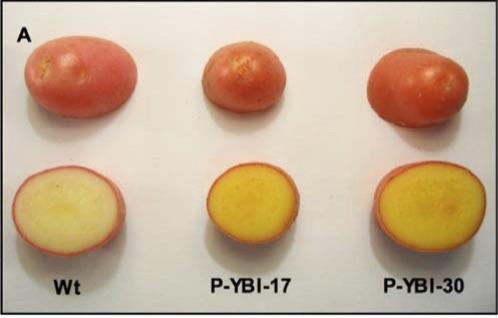Genetically modified crops have had no shortage of controversy over the years, much of it rooted in fear and the general lack of fundamental scientific knowledge. Yet researchers have pushed forward in developing crops that could help boost basic nutritional requirements for developing nations that rely heavily on foods that are deficient in essential vitamins. One example comes by way of new research from investigators at The Ohio State University and the Italian National Agency for New Technologies who have developed a “golden” potato with significantly increased levels of vitamins A and E. Findings from the new study were published recently in PLOS ONE in an article entitled “Potential of Golden Potatoes to Improve Vitamin A and Vitamin E Status in Developing Countries.”
The research team found that a serving of the yellow-orange lab-engineered potato has the potential to provide as much as 42% of a child’s recommended daily intake of vitamin A and 34% of a child’s recommended intake of vitamin E. Moreover, the researchers concluded that women of reproductive age could get 15% of their recommended vitamin A and 17% of recommended vitamin E from that same 5.3-ounce (150-gram) serving.
The potato is the fourth most widely consumed plant food by humans after rice, wheat, and corn, according to the U.S. Department of Agriculture. It is a staple food in some Asian, African, and South American countries, where there is a high incidence of vitamin A and vitamin E deficiencies. Improving staple crops through genetic manipulation is becoming increasingly important as global population rates continue to rise steadily and climate change begins to threaten many croplands. Nature News recently reported on an international effort to sequence the notoriously complicated wheat genome, with the hopes of better understanding its growth requirements and improving its nutritional output.
“More than 800,000 people depend on the potato as their main source of energy, and many of these individuals are not consuming adequate amounts of these vital nutrients,” explained senior study investigator Mark Failla, Ph.D., professor emeritus of human nutrition at Ohio State. “These golden tubers have far more vitamin A and vitamin E than white potatoes, and that could make a significant difference in certain populations where deficiencies—and related diseases—are common.”
Vitamin A is essential for vision, immunity, organ development, growth, and reproductive health. And Vitamin A deficiency is the leading cause of preventable blindness in children. Vitamin E protects against oxidative stress and inflammation, conditions associated with damage to nerves, muscles, vision, and the immune system.
Interestingly, the study investigators created a simulated digestive system including a virtual mouth, stomach, and small intestine to determine how much provitamin A and vitamin E could potentially be absorbed by someone who eats a golden potato. Provitamin A carotenoids are converted by enzymes into vitamin A that the body can use. Carotenoids are fat-soluble pigments that provide yellow, red and orange colors to fruits and vegetables. They are essential nutrients for animals and humans.
“We ground up boiled golden potato and mimicked the conditions of these digestive organs to determine how much of these fat-soluble nutrients became biologically available,” Dr. Failla noted. The main goal of the work was to examine provitamin A availability. The findings of the high content and availability of vitamin E in the golden potato were an unanticipated and pleasant surprise, Dr. Failla said.
The golden potato, which is not commercially available, was metabolically engineered in Italy by a team that collaborated with Dr. Failla on the study. The additional carotenoids in the tuber make it a more nutritionally dense food, with the potential of improving the health of those who rely heavily upon potatoes for nourishment. While plant scientists have had some success cross-breeding other plants for nutritional gain, the improved nutritional quality of the golden potato is only possible using metabolic engineering—the manipulation of plant genes in the lab.
“We have to keep an open mind, remembering that nutritional requirements differ in different countries and that our final goal is to provide safe, nutritious food to 8 billion people worldwide,” remarked study co-author Giovanni Giuliano, Ph.D., research director at the Italian National Agency for New Technologies, Energy, and Sustainable Development at the Casaccia Research Center in Rome.
Dr. Failla agreed and added that “hidden hunger—deficiencies in micronutrients—has been a problem for decades in many developing countries because staple food crops were bred for high yield and pest resistance rather than nutritional quality. This golden potato would be a way to provide a much more nutritious food that people are eating many times a week, or even several times a day.”







